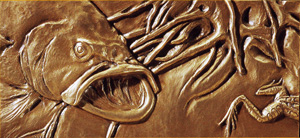Metal Musings: Bronze Works by Richard Summons
 Fast Food, by Richard Summons.
Fast Food, by Richard Summons.Photo courtesy of Richard Summons.
After careers in ceramics and safety equipment, Richard Summons left the corporate arena behind to start a new chapter devoted to metal sculpture in 1997.
With a 2,520-square-foot studio, he began experimenting and soon discovered his affinity for bronze in both cold and heated forms. And, while he works with other metals and materials, copper alloys account for a good portion of his business, which is more than 75% bonded bronze sculptures.
With a background in sculpture from varied ceramics projects, Summons began working with a foundry called A.R.T. Research Enterprises in Lancaster, Pennsylvania, sometimes taking on projects from them. He also has some of his hot-casting work done by Laran Bronze, Inc., outside of Philadelphia. Summons sources his bronze powder for reliefs from Polytek Development Corporation in Easton, Pennsylvania, more than an hour north of his studio.
His first relief sculpture in bonded bronze paid tribute to a friend’s cat, and he soon noticed the marketability of how animals matter significantly to people, whether as a pet or revered creatures from forests, ponds, mountain dens or the ocean.
He enlarged a photograph of the feline and created a black and white copy.
“I placed the copy on top of the clay billet which we use for the relief work itself,” Summons says. “Michelangelo did the same thing when he did frescos.”
In bronze reliefs, Summons sets a paper copy of his inspiration overtop of non-firing clay and follows the lines in it with a pin tool, piercing holes downward as a form of tracing.
“It looks like a Connect-the-Dots paper,” he says. “The difference and challenging part of continuing and making a relief is the ability to go below the surface of the clay or to build up on top of it.”
 Gossip, by Richard Summons.
Gossip, by Richard Summons.Photo courtesy of Richard Summons.
His bonded bronze powder is blended with a binder, usually a polyester resin, before pouring into a mold of the art he wants to mimic, traced on and carved into clay.
His hot-cast bronze works are often animal sculptures, too. After delving into public shows, he learned that turtles have a widespread audience of enthusiasts.Their monochromatic warmth in bonded bronze is a chance to bring their peaceful-seeming demeanors into homes, businesses and art galleries.
“Turtles are amazingly marketable items,” he says. “They don’t seem as aggressive as an alligator or snapping turtle. Most turtles seem quite pleasant. It’s one of the reptiles and amphibians which are nice to have, and it’s amazing how many people like them.”
His work is also popular with wildlife organizations.
The Decoys & Wildlife Gallery in Frenchtown, New Jersey, is one of several venues carrying a revolving supply of Summons’s sculptures.
Floral scenes, ballet slippers, and portraits of people are some focuses which Summons practices besides animals in bronze reliefs.
Summons teaches his skill-set to students who he takes on as learners in his studio, and as needed, he makes specialized hot-cast bronze awards for Albright College, Reading Area Community College, Kutztown University and Alvernia University in his region.
More than anything, Summons appreciates the process of bonded bronze, and its cost-effective nature compared to hot-cast bronze.
“I can sometimes fool the foundry workers so that they can’t tell the difference between one and another,” he says of bonded versus hot-cast bronze pieces.
Resources:
Also in this Issue:
- NYC Art in the Parks Brings Emerging Bronze Sculptors to the Public Eye
- Kait Rhoads: Fluidity Through Copper
- Metal Musings: Bronze Works by Richard Summons
- Copper on the Stove: Honoring Duparquet, Huot & Moneuse, Co.
- Jaume Plensa’s Newest Bronze Exhibition on View at the Galerie Lelong
